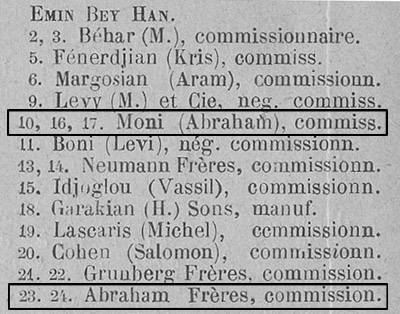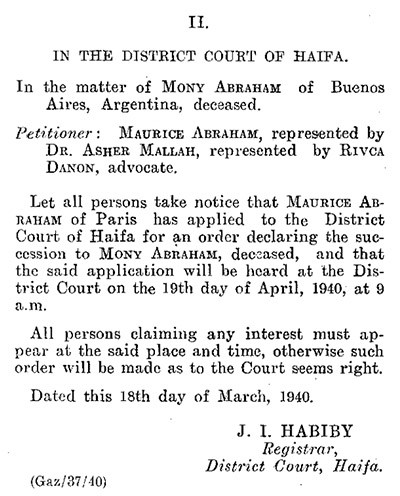Mony Abraham
Actual name: Salomon, Solomon, Shlomo.
Alternate spelling: Moni.
Mony Abraham was born on November 22 1889 (November 10 according to the Julian calendar in use at the time of his birth), in Ruschuk, Bulgaria, the son of Mamo Abraham and Lea Jacob. He had three older brothers: Haim, Moshe (Moritz), and Isak Mamo.
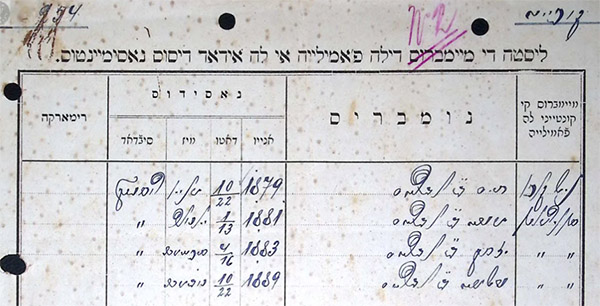
Birth records of the Abraham brothers drawn by the Sepharadic Congregation of Ruschuk (Ruse) in Ladino, 1901.
Mony is the last entry, under his birth name Shlomo (Solomon).
Source: Jabotinsky Archives
According to Sarah Cohen Eldar,
"Moni, the youngest, was given and adopted by his aunt Mazal just after he was born. (He) was adopted by the eldest sister of his mother. His mother had promised her sister while she was pregnant that she would give birth for her sister.
In the family he was known as Moni Ventura, but perhaps he (later) decided to return to his biological name. Your father (Uriel) told (me) about it*."
*Note that I haven't found any other mentions of Mony's adoption, and have only seen documents referring to him as Mony Abraham.
Lea, Mony's biological mother, died of turberculosis when he was two years old. Less than two years later, his father, Mamo, died of the same disease.
The earliest photo of Mony is a group portrait of the four Abraham brothers, taken in 1896, two years after their parents' death.

Haim, Moritz, Isak and Mony Abraham, Rustchuk, 1896.
(Collection of the author)

Mony Abraham, age 7, Ruschuk, 1896.
Nothing more is known about Mony's early years. I assume that he attended the same schools as his brother Haim, starting with the primary boys' school run by The Alliance Israélite Universelle in Rustchuk, probably followed by the Rustchuk Gymnasium. Finally, he may also have completed his studies in the Kronstadt Evangelical Realschule in Brașov.
Constantinople
Like his brothers Haim and Moritz, Mony left Ruschuk and moved to Constantinople, although when, or whether he came with them is not known.
According to the 1921 and 1922 issues of the Annuaire Oriental, Mony lived at 52 Yeni Yol street, Apartment Rachel #9, in Galata (now Karaköy), the same neighborhood as Haim. Although going by Mony, he was listed under his given name, Salomon.
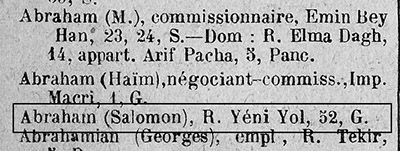
Annuaire Oriental 1921, page 229

Annuaire Oriental 1921, page 1223
The street, also called "rue Okdji Moussa", was located between "rue Chiche-Hané" and "rue Voïwode" (Voyvoda). (The Austro-German-Jewish school which housed the Maccabi club was nearby, 21 rue Chiché-Hané.)
The building housed the Bulgarian Consulate (apartments 1 to 7). Other inhabitants included a commisionaire, an "owner" (presumably the owner of the building), and a customs officer (or possibly a professional specializing in facilitating the import of goods). Neighbors included a wide range of occupations, including bank employees, merchants in manufactured goods, lawyers, currency traders, dentists, a jeweler, two rabbis, and an antique dealer. About half of the names were Jewish, with the rest split between Greek and Armenian, with just a handful of Turkish surnames. Nearby businesses included a shoemaker, a pharmacy, two haberdasheries, a bicycle merchant, a butcher, a marble dealer, a tobacconist, an umbrella store, and a couple of grocery stores.
(Joseph Niego, the agronomist and founder of the B'nai B'rith Grand Lodge District XI in Constantinople, had lived in the same apartement 10 year before. It is not known if this was just a coincidence, or the result of some personal connection.)
(The 1922 issue of the Annuaire Oriental has two entries for a Salomon Abraham - one on Yeni Yol street in Galata, the other on Misk street in Pera. It is not clear if they are both for the same person, or two unrelated people; The 1921 issue had a Salomon Amram, negociant, at the same Misk address, so this may simply be a mistake.)
Annuaire Oriental 1922
Occupation
Like his older brothers, Mony was a merchant who imported manufactured products from Europe into the Ottoman Empire. This occupation was variously listed under "commissionnaire", "negociant", or "import/export" in the Turkish trade directories.
Mony was listed as a trader of manufactured goods ("Nég. en Man." = "Négociant en manufactures") in the 1920-1921 edition of the "Guide pratique et indicateur des voies et communications de Constantinople et banlieue", and he was based in the Emin Bey Han, the same building that housed Abraham Frères, his brothers' company.

Guide pratique et indicateur des voies et communications de Constantinople et banlieue, 1920-1921.
(Source: gallica.bnf.fr)
Mony was also listed as "Abraham Moni", a "commissionnaire", in Emin Bey Han in the 1921 "Annuaire Oriental". (The inverted first/last names and the different spelling for Mony are a mistake since he is also listed in the Guide Pratique. Another discrepancy: the Annuaire Oriental lists three offices (10, 16, 17) under his name, whereas the Guide Pratique lists only one - number 16.)
I assume that his business was smaller than that of Abraham Frères, as only 2 package cards addressed to him have surfaced so far, compared to 40 for Abraham Frères.
Two incoming parcel cards addressed to Mony suggest that he may have specialized in chemical products for the textile industry. One was for a shipment of iron sulphate, a product used for inks and dyes; the other for calcium hydrochloride, a bleaching agent for textiles. (Later, in Argentina, Mony would own a textile business.)
Parcel Cards
Bleaching powder package from Hungary, 1917.
Parcel from Budapest, Hungary, for bleaching powder.
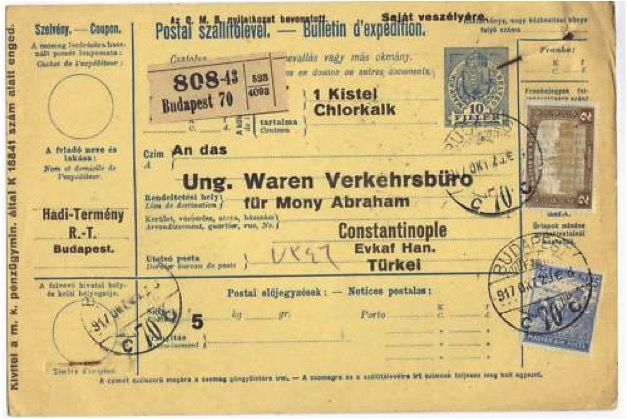
Parcel card for bleaching powder from Hungary, 1917.
(Scan courtesy of Mehmet Sadettin Fidan)
Chlorkalk = chlorinated lime (also known as bleaching powder).
"Kistel" at the top of the card may be a typo for "1 Kiste" = "1 box".
Addressed to Mony Abraham through the "Ung. Waren verkehrsbüro" (Hungarian Products (transport?) Office).
The stamp on the left "Hadi Termény Részvénytársaság" is for Hungarian economic organization "War Produce Company" which operated during the war until the end of 1919, when its role was taken over by the newly established Ministry of Agriculture.
Iron sulfate
Parcel Card for iron sulfate from Budapest, Hungary.
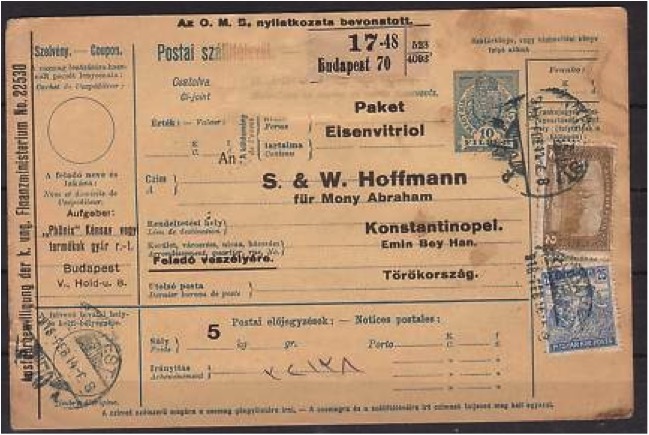
Parcel card for iron sulfate.
(Scan courtesy of Mehmet Sadettin Fidan)
Nationality
On the 1925 Buenos Aires immigration manifest, Mony's nationality was listed as Bulgarian, but on his 1938 death certificate, he was described as a Spanish citizen. I assume that he acquired Spanish citizenship like his brother Moritz, but it's not clear whether he used multiple passports, or acquired Spanish nationality at a later date.
Social Circle
Mony probably shared the same social circles as his brothers. For example, a letter addressed to Aaron Aaronsohn in July 1916 shows that he was in contact with the agronomist and NILI spy ring leader.
Mony wrote:
I am surprised that I haven't heard from you since your departure. Do you have so little time that you can't spare a moment for your new friends? [...]
My business isn't bad - financially things could be better, but I can't complain, times are tough. [...]
In the meantime give my best regards to Sarah (*).
* Sarah Aaronsohn, the future NILI spy, was married to Mony's brother, Haim Abraham.
Surprisingly, Mony's address on this letter was "Hotel Rubin, Pera, Constantinople", an hotel of "third category" according to the Annuaire Oriental. Why did Mony reside in a hotel? Had he, like his brother Haim, relocated to Germany during the war, and was only temporarily in Constantinople on business? Or was this a permanent arrangement?
The other interesting detail is that this letter was sent in July 1916, four months after Sarah Aaronsohn had left for Palestine, suggesting that it was still believed that Sarah's departure was not definitive and that she would be returning to her husband Haim.
Marriage
Mony married Elfriede Mädi Wertheimer from Bucharest, Romania, in Constantinople in 1917.
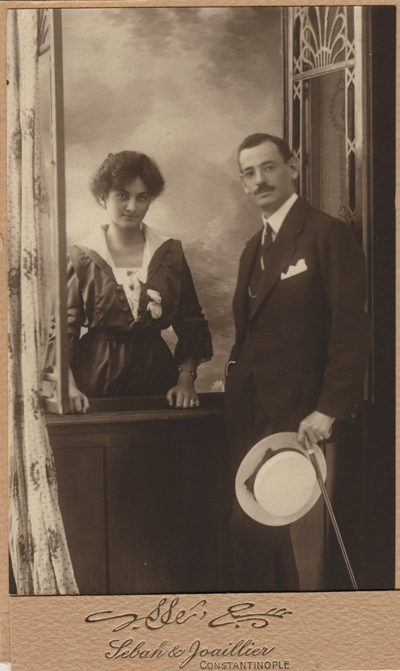
Mony and Mädi Abraham in Constantinople.
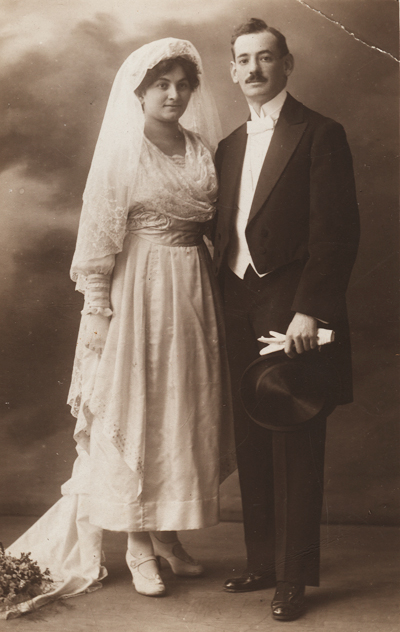
Mony and Mädi Abraham in Constantinople.
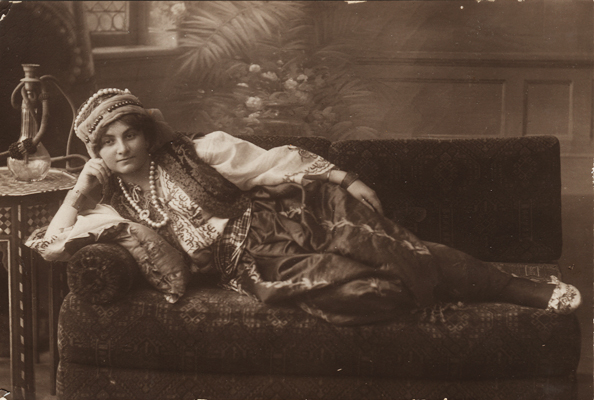
Mädi in Constantinople, 1917.
"Souvenir from my stay in Constantinople - 1917."
Note: this photo was taken in the same studio as the portraits of the Datnowsky siblings dressed in "Oriental" costumes in 1910.
| Chief Rabbinate Marriages 1887-1999 - Istambul | |||||||
|---|---|---|---|---|---|---|---|
| Groom surname | Groom given name | Given name of groom's father | Bride given name | Given name of bride's father | Bride surname | Date | Reference number |
| ABRAHAM | Salom. | Haim | Elfrida | Yzidor | VERTHAYMER | 1917 | 82-166 |
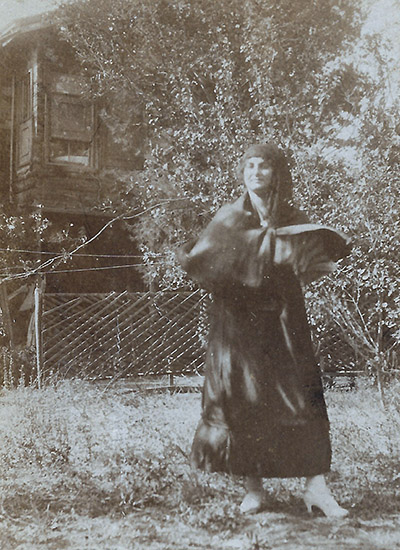
Mädi in Erenkeuy near Constantinople, 1919
In 1923, Mony and Mädi adopted a daughter, Irene ("Reni"), born the same year in Constantinople.
1924 - Düsseldorf
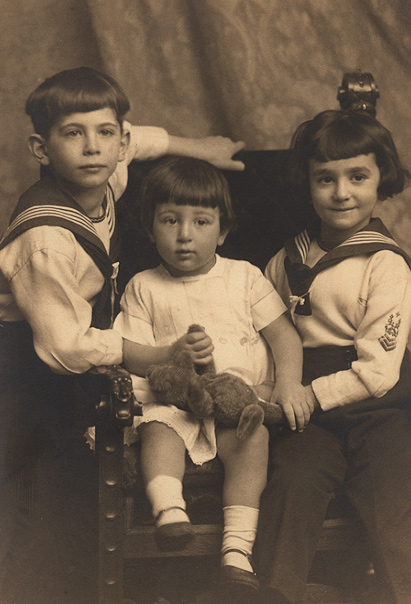
Reni surrounded by her cousins Gisi and Uriel Abraham in Düsseldorf, 1924.
This photo of Reni with her cousins was taken while Mony and his family were visiting his brother Moritz in Düsseldorf. I don't know whether they were vacationing, had left Turkey and were now living in Germany, or were on their way to South America. They would immigrate to Argentina at the end of the following year.
Argentina
Mony, Elfriede, and Irene immigrated to Buenos Aires, Argentina in December 1925.
| Manifest / Immigration Registry | |||||||||
|---|---|---|---|---|---|---|---|---|---|
| Last Name | First Name | Age | Civil Status | Nationality | Place of Birth | Occupation | Arrival Date | Ship | Port |
| Abraham | Mony | 36 | Married | Bulgarian | Rustshouk | Merchant | 1925/12/02 | SS Cap Polonio | Hamburg |
| Abraham | Elfriede | 32 | Married | Romanian | Bucharest | Homemaker ("Labores") | 1925/12/02 | SS Cap Polonio | Hamburg |
| Abraham | Irene | 2 | Single | Turkish | Constantinople | 1925/12/02 | SS Cap Polonio | Hamburg | |
Source: cemla.com/buscador
Why did Mony and his family immigrate, and why Argentina? Did they leave Turkey because of the turmoil in the newly created Kemal republic? Or was it purely for economic reasons, with the possibility of bigger opportunities in the new world?
According to my father, Mony wrote "America is something else!". (Unfortunately, it seems that he did not preserve this correspondance.)
My father commented: "The Ottoman Empire was over by then. When my father (Moritz) first came to Constantinople the Ottoman Empire was a large ensemble, and Constantinople was a great metropolis, with a large colony of foreigners... "
Argentina seems to have been a popular immigration destination for Sephardic Jews, in part because of the familiar language. Mony might even have had relatives from Ruschuk who would have preceded him there. (Immigration manifests include several people from Rushtshuk named Abraham, although their professions - laborers, tailors or bakers - suggest that they may have been unrelated. It is however possible that second-degree relatives had preceded Mony in Argentina, for example from the Ventura family.)
(A merchant named Isaac Abraham, born around 1883, who came to Argentina in 1916, might either have been Mony's brother Isak, a relative, or just a coincidence. How many people named "Isaac Abraham", born in or around 1883 in Rushstshuk and with the profession of merchant could there be? On the other hand, I'm not aware that this Isak emigrated to Argentina, or that he was ever married. But this can't be completely rulled out as I have very little information about him.)
| Manifest / Immigration Registry | |||||||||
|---|---|---|---|---|---|---|---|---|---|
| Last Name | First Name | Age | Civil Status | Nationality | Place of Birth | Occupation | Arrival Date | Ship | Port |
| Abraham | Isaac | 33 | C | Rushtshuk | Merchant | 1916/11/14 | Malte | Santos | |
Surprisingly, Irene's name appears on a December 1929 immigration manifest, but not her parents'.
| Manifest / Immigration Registry | |||||||||
|---|---|---|---|---|---|---|---|---|---|
| Last Name | First Name | Age | Civil Status | Nationality | Place of Birth | Occupation | Arrival Date | Ship | Port |
| Abraham | Irene | 6 | S | Turkish | Constantinople | Unknown | 1929/12/06 | SS General Osorio | Hamburg |
Source: cemla.com/buscador and hebrewsurnames.com
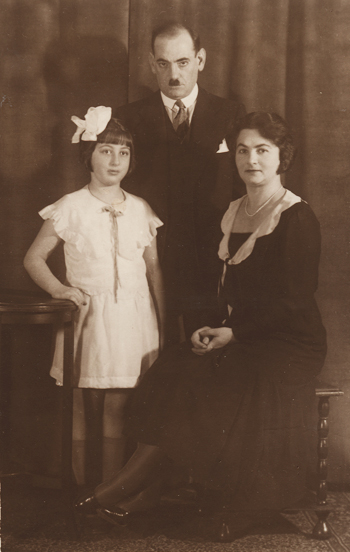
Mony, with his daughter Reni and wife Mädi. Buenos Aires, 1931.
By December 1931, his address was: 1381 Alsina, Buenos Aires.
Zionist Activities
Unlike his brothers Haim and Moritz, both active within the leadership of Zionist organizations in Rustchuk and Constantinople, Mony hasn't left any traces of Jewish activism during his early years.
He did however get involved in Zionist activities later in Argentina. In 1933, he was one of the founders of the "Centro Sionista Sefaradi". In the August 29, 1941 issue of the weekly magazine "Israel" published in Buenos Aires, he is mentioned as having been the president of the Sephardi Zionist Center until his death.
An inscription on his tombstone stating that going to Eretz Israel was his "life's ideal", and the publication of his death notice in the Jüdische Rundschau, the organ of the Zionist Association in Germany, also indicate that he was, at least later in life, a dedicated Zionist.
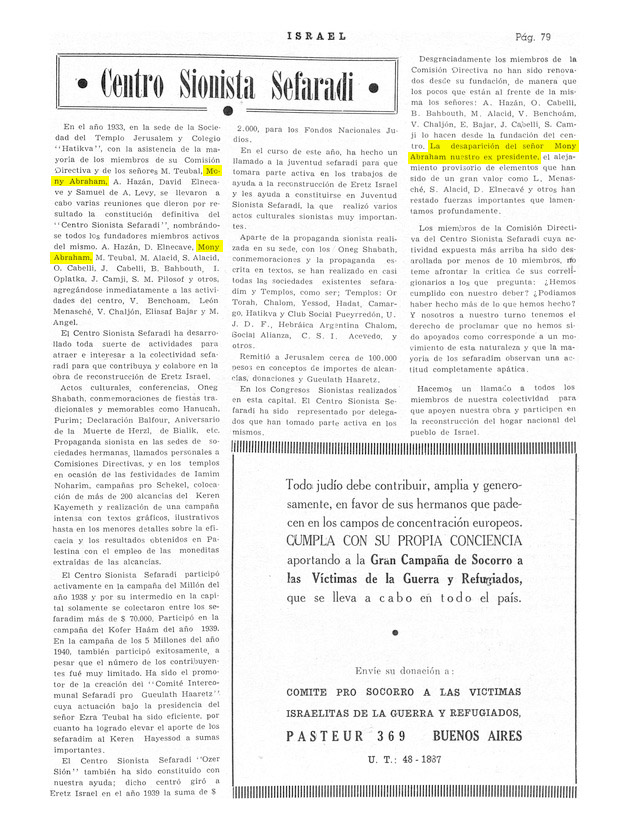
Weekly magazine "Israel", 25th anniversary issue: no. 973/4 (29 August, 1941)
Source: Judaica collection at University of Florida
Despertar Del Desierto
In 1936, Mony Abraham registered the trademark and logo for "Despertar Del Desierto" ("Desert Awakening"), a fabric company.

Boletin Oficial de la Republica Argentina
(Official Gazette of the Argentine Republic)
August 21, 1936.
Patent and trademark management.
DESPERTAR DEL DESIERTO
July 27, 1936. - Mony Abraham and Co.
To distinguish cloth and fabrics in general, knitwear, table linen and lingerie, of class 15.
Notice no. 3.430.
By 1938, Mony and his family now resided at 5058 Rivadavia in Buenos Aires.
Death in Nice
On April 3, 1938, Mony set out on a trip to Palestine with Elfriede. (It is unclear whether their daughter Irene accompanied them.) During the voyage, he fell ill and was disembarked in Nice—likely at Villefranche-sur-Mer—in the south of France.
From Nice he contacted his brother Moritz, who traveled from Paris to be with him. Moritz, in turn, called his son Uriel, who also came. Uriel later recalled, "We saw him die".
Mony passed away on June 8, 1938, in a clinic (“maison médicale”) on Avenue Stephen Liégeard in Nice. He was 49 years old.
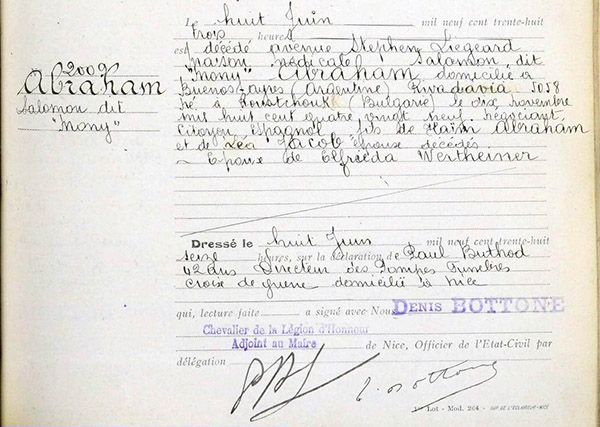
Mony's death certificate.
Surprisingly, his death certificate incorrectly listed his father's name as Haim.
Le huit Juin mille neuf cent trente huit, trois heures
est décédé avenue Stephen Liegeard maison médicale,
Salomon, dit "Mony" Abraham,
domicilié a Buenos Ayres (Argentine) Rivadavia 5058,
né a Roustchouk (Bulgarie) le dix novembre mille huit cent quatre vingt neuf
négociant, citoyen espagnol,
fils de Haim Abraham et de Léa Jacob époux décédés
Epoux de Elfrieda Wertheimer
Dressé le huit juin 1938 seize heures.
On June 8, 1938, three o'clock
died at Stephen Liegeard Avenue, medical center,
Salomon, known as "Mony" Abraham,
residing in Buenos Aires (Argentina), Rivadavia 5058,
born in Roustchouk (Bulgaria) on November 10, 1889
merchant, Spanish citizen, son of Haim Abraham and Léa Jacob, deceased spouses.
Husband of Elfrieda Wertheimer.
June 8, 1938, four o'clock in the afternoon.
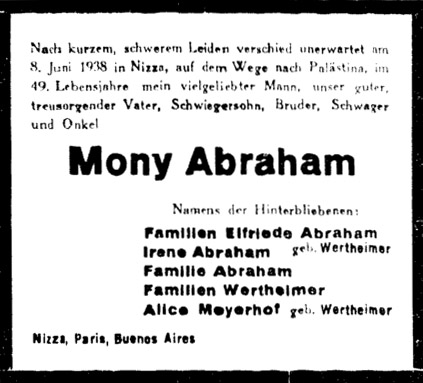
Mony Abraham's death announcement. Jüdische Rundschau, issue 49, 21.6.1938.
(Source: sammlungen.ub.uni-frankfurt.de)
After a short, severe illness, my beloved husband, our good, caring father, son-in-law, brother, brother-in-law and uncle, died unexpectedly on June 8, 1938 in Nice, on the way to Palestine, at the age of 49.
Mony Abraham
Names of the survivors:
Elfriede Abraham family, née Wertheimer
Irene Abraham
Abraham family
Wertheimer family
Alice Meyerhof, née Wertheimer
Nice, Paris, Buenos Aires
Two details about the death notice are worth noting. First, it published in the Jüdische Rundschau, the official organ of the Zionist movement in Germany. While it confirms Mony's connection to the Zionist cause, it's not clear why the family chose a German publication.
More surprising is the apparent exclusion of Haim. While the plural "Familien" is used for the Wertheimer families, the singular "Familie" is used for the Abrahams. Moreover, Haifa—where Haim was then living with his wife—is absent from the list of cities. This suggests that, sadly, the rift between Moritz and Haim had not healed—or, worse, that Haim may also have been estranged from Mony.
Mony was buried in Nice on July 15.

Mony Abraham's tombstone. Cimetière Caucade, Nice.
(Source: groups.jewishgen.org, via David Choukroun)
Mony Abraham
Né à Roustchouk
Le 10 Novembre 1889
Parti de Buenos Aires le 03 Avril 1938
Mort à Nice le 08 Juin 1938
En route pour Eretz Israël
Idéal de sa vie
Born in Ruscthuk
November 10, 1889
Left Buenos Aires on April 3, 1938
Died in Nice on June 8, 1938
On his way to Eretz Israel
The ideal of his life
He was buried (or maybe re-buried?) by members of the Coenca family - relatives of his mother's. (Joseph Coenca, whose name appears on the same tombstone, was Mony's uncle; born in Istanbul, the father of Flore Coenca, he died in Nice in 1942. )
(My father recalled: "They wrote to me, asking if I allowed them to bury him in the family burial vault", suggesting that this may have happened at a later time, when his father Moritz was not alive anymore.)
Succession
After his death, disputes arose around his inheritance, involving, I believe, land in Argentina. According to my father, it was however "all for nothing: in the end they realized the land wasn't worth anything."
A document from the District Court of Haifa, Israel, shows that Moritz started legal proceedings regarding Mony's succession in Mandatory Palestine in the spring of 1940.
IN THE DISTRICT COURT OF HAIFA.
In the matter of MONY ABRAHAM of Buenos Aires, Argentina, deceased.
Petitioner: MAURICE ABRAHAM, represented by DR. ASHER MALLAH, represented by RIVCA DANON, advocate.
Let all persons take notice that MAURICE ABRAHAM of Paris has applied to the District Court of Haifa for an order declaring the succession to MONY ABRAHAM, deceased, and that the said application will be heard at the District Court on the 19th day of April, 1940, at 9 a.m.
All persons claiming any interest must appear at the said place and time, otherwise such order will be made as to the Court seems right.
Dated this 18th day of March, 1940. J. I. HABIBY Registrar, District Court, Haifa
By then, Moritz's remaining brother, Haim, lived in Haifa, which probably explains the location of this legal proceeding. What was at stake however is not clear. Also not clear is why this act only involved the two surviving brothers, since Mony's wife was apparently still alive in Argentina. (According to later depositions by Ronya, Elfriede died in 1953.)
Note that Moritz was represented in Haifa by Asher Mallah, his (and Haim's) brother-in-law.
A legal announcement in the April 3, 1941, issue of the Boletin Oficial de la Republica Argentina announces the end of Mony Abraham's company.

Dissolution of Mony Abraham & Co. 1941 in "Boletin Oficial de la Republica Argentina".
Source: ia801704.us.archive.org
"It is hereby announced that the dissolved company Mony Abraham & Co., in liquidation, domiciled at Victoria 1144, has been totally and definitively liquidated, with Mr. Joseph Ventura, domiciled at Victoria 1144, having taken charge solely of the collection of the "Miscellaneous Debtors" item and of the company's creditors, on behalf of and under the same.
Claims: Dr. Salvador Kibrick, Uruguay 440.
c.29 Mar.-No. 2078-v.3 Apr
While the name Ventura was common in the Sephardic community in Rouschouk, it is possible that Joseph Ventura, Mony’s partner, was a relative. The Abraham family was related to a Ventura family from Vienna—Mair and Rachel Ventura. Additionally, according to a story recounted by Sarah Cohen Eldar, Mony was adopted by his aunt Mazal Ventura.
.Mony's succession would drag on for over a decade. A letter from the Israeli Ministry of Justice addressed to "Mr. Abraham" from January, 1954, asked:
"I would be very much obliged if you would inform me whether you intend to apply to an Israeli Court for an Order of Succession in respect of the estate of the late Mr. Moni Abraham."
According to handwritten notes by Ronya, Mony's wife Elfriede died in Buenos Aires in 1953, "leaving no children". This suggests that Mony's daughter, Irene (Rene), may have died at a young age, or else, that Ronya was not forthcoming, or mistaken.
In addition, my old handwritten notes indicate that Mony had remarried a woman named Regina Witner. Based on Mony's death notice, however, this must have been incorrect.
- Special thanks:
- Mehmet Sadettin Fidan for graciously sharing documents and information related to Mony Abraham's professional activity.
- Sources and References:
- Interview with my father, 1993.
-
Article from "Israel" weekly magazine, Buenos Aires, Argentina. 25th anniversary issue : no. 973/4 (29 August, 1941)
Publisher: Z. Levy
Judaica collection at University of Florida - Centro de Estudio Migratorios (C.E.M.L.A.) (Argentina Immigration manifests)
- groups.jewishgen.org
- groups.jewishgen.org
- www.findagrave.com (contains incorrect date of death)
- archives.saltresearch.org (Annuaire Oriental, 1921)
